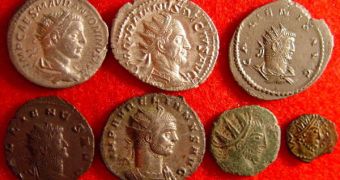While archaeologists have unearthed a large number of artifacts pertaining to the ancient Roman Empire, and have inferred many aspects about the official history of its leaders, very little is known at this point about some basic facts, such as the size of the population living in the city of Rome, the capital of the empire, and, indeed, the center of the world in those days. Now, using coins found in caches, experts have managed to establish with a fairly high degree of certainty the approximate number of people living in the most important city in the world, LiveScience reports.
The estimates relate to a period spanning the fifth to the first centuries B.C., a time known as the Republican period of Rome. During these four hundred years, adult males in the city could be enlisted into the army, needed to pay taxes, and could also be given the right to vote. In order to keep track of the number of young boys at its disposal, the Empire needed to conduct periodic censuses of the population. This was crucial in designing long-term, conquest plans, as generals needed to know on how much able bodies they would be able to rely a few years ahead of time.
From about 350 to 200 BC, experts estimated that the number of young males in the population had risen from 200,000 to 400,000. However, these numbers do not match the official ones from Roman censuses, which indicated an increase to about four to five million males. The censuses were organized by the first emperor, Augustus, in the first centuries BC and AD. What could account for this difference, at first glance, would be the Roman practice of granting citizenship to some people outside Rome, as, for example, those from the conquered territories. But, even then, the differences were too great.
University of Connecticut theoretical biologist Peter Turchin and Stanford University ancient historian Walter Scheidel took it upon themselves to solve the mystery, and started analyzing buried, gold hoards dating back to those days. “Hoards are an excellent indicator of internal turmoil. This is a general phenomenon, not just in Rome,” Turchin explains. They uncovered that, indeed, there had been a sharp decline in population after 100 BC, which led them to believe that the census might have included women and children as well.
“This may seem like an arcane dispute, but it isn't really because the difference is so large – 200 percent. This model is much more consistent with the low count. I'm not sure that by itself it has absolutely proven it, but it certainly provides additional evidence for the low-count hypothesis,” Scheidel adds. The finds are detailed in the October 5 issue of the respected journal Proceedings of the National Academy of Sciences (PNAS).

 14 DAY TRIAL //
14 DAY TRIAL //